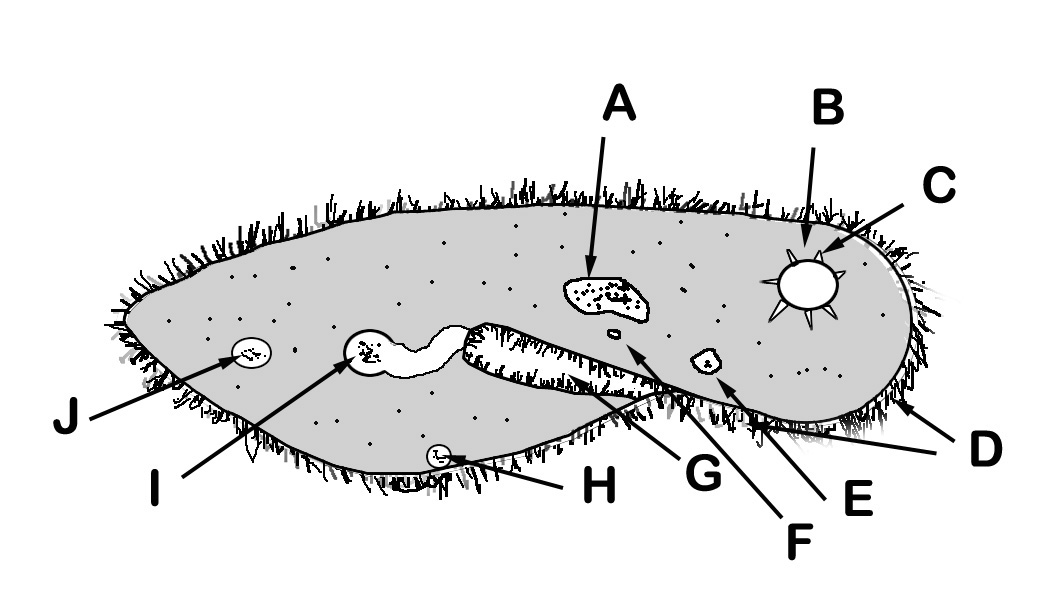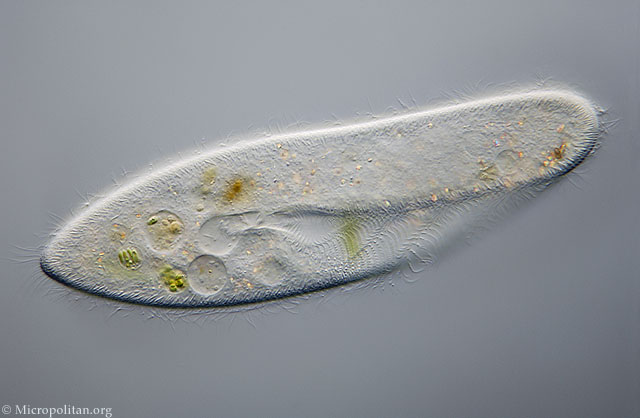The Paramecium Enigma
(Do one cell organisms have a form of intelligence?)
by
Mol Smith
(November 2014)

Image (c) Richard Howey USA
The world at the microscopic scale perhaps has mysteries which could lead to giant leaps in our understanding of our universe and our reality. One of my main interests is studying human knowledge at the edge of our most advanced levels of understanding and exploration. Much of the leading edge of science has ideas and hypotheses which border on the metaphysical and I believe also leach into other areas of less scientific study - philosophy for example. In fact I am currently
writing a book which I hope to publish next year as a result of my own studies. Much of our 'new' gains in scientific application have come about through the study of the quantum world. It is a branch of science (Quantum Physics) where, although our mathematics enable extraordinary exploitation of the effects we encounter in the sub-atomic world, no person on the planet actually has any real grasp of what really happens there. What we discover by experiment defies human intuition and comprehension.
Part of my research has brought to light work by Roger Penrose, an eminent mathematician and one of the bright minds in the early Stephen Hawking camp back a few decades ago. Of particular interest to me is some of the text from one of his many books 'Shadows of the Mind' ISBN 9780099582113. It refers to characteristics of the humble Paramecia (Paramecium pl.).
This is a single celled organism - an entity contained completely within a single unitary cell. Here is my rough sketch of a type of Paramecium.

| A = Macronucleus D = Cilia G = Gullet J = Food Vacuole circulating |
B = Contractile vacuole E = Trichocyst H = Anal pore |
C = Radiating canal F = Micronucleus I = Food vacuole forming at base of gullet |
And an image (below) taken at the microscope by Wim van Egmond (c) Wim van Egmond

Paramecia possess interesting characteristics and behaviour. They are able to detect food in the form of bacteria, algae, and yeasts in the water, swim towards them by using waving cilia (fine hair-like processes) on the surface of the cell membrane, absorb food into a gullet to create food vacuoles, and they are able to produce by both sexual and non-sexual reproduction, depending on environmental conditions.
More... they are also able to detect light, and perhaps the most profound of all - they are able to make a series of maneuvers to negotiate they way around obstacles they 'bump' up against. In these circumstances, they back up, change their swimming angle, and swim forward again. This might be repeated several times until they find a way past.
Some observers have witnessed behaviours which suggest they are able to retain information in some undefined and inexplicable way, although this suggestion is heatedly challenged by other experts
The enigma though: what is it that is so mysterious about this tiny life-form?
Neurons! Yup, nerve cells! They don't have any. How could they? They are, as I said, one celled entities. And yet, a series of actions, preceded by the 'sensing' of an object is apparently orchestrated within the cell to maintain a path towards its objective. Animals in the macro world use nerves and a nervous system to co-ordinate signals from senses to a brain and from brain to muscles to initiate action. Some forms of plants (the well know one being the Venus fly trap) can take simple actions in response
to external stimuli.
There is no known mechanism for the paramecium to be able to detect (sense) an obstacle, alter the angle of sweep along the cilia to move backwards, time that until it is clear, change the sweep of the cilia to change the angle of the forward cell motion that then follows. They are considered to be animals, although like many small living forms, such classification can be quite a subjective and difficult conclusion to make. Some single celled organisms behave as plants and also as animals.
If the paramecium had a brain or even a small group of nerve cells somewhere, we could understand a system exists within it to preside over these actions. Nerve cells (neurons) are the only cells we really understand as being able to become an organised bio-mechanism of rudimentary or sophisticated intelligent actions.
It has led Roger Penrose to explore what other processes or mechanisms might be going on as part of his exploration into the human brain and mind. One of the ideas pursued for a number of years is the notion that neurons alone may not be responsible for the kind of profound intelligence shown in human beings, and that there is a possibility that quantum-like activity plays a part in that. Furthermore, for quantum effects to take place, an organ or asset of an organ must be able to resolve or sense quantum effects
and in some manner instigate an information exchange to the non-quantum neurons of the brain.
There are processes in the brain which are small enough and abundant enough to be considered potential sites for quantum activity. They are called microtubules. As you will understand, studying anything in the brain, even the activities of brain cells is quite difficult, let alone trying to detect sub-atomic activity at another entirely different scale.
So, here's a thing. Paramecium have microtubules too!
Now, let me say straight away, that the paramecium is not the only microscopic life form to exhibit what we would consider to be intelligent activity. Some forms of Rotifer sense prey so accurately that it's likely they are applying aspects of 'triangular positioning' to pin-point their prey so precisely in both the x and y axes. Once located, they virtually throw a self-contained net, like a hood, (membrane) over the unlucky victim and draw it in. Nearly all the larger microscopic forms exhibit behaviours which
seem far more advanced and profound to be the result of chemical-effect reactions per se.
I am going to let Roger Penrose take over for a moment here, by typing a paragraph or two from his book (without permission being asked for, may I say, but I hope might encourage others to buy it)...
There must be indeed be a complicated control system governing the behaviour of a paramecium - or indeed other one-celled animals like the amoeba - but it is not a nervous system. The system responsible is apparently part of what is referred to the cytoskeleton. As its name suggest, the cytoskeleton provides the framework that holds the cell in shape, but it does more. The cilia themselves are endings of the cytoskeleton fibres, but the cytoskeleton also seems
also to contain the control system for the cell, in addition to providing 'conveyor belts' for the transporting of various molecules from one place to another. In short, the cytoskeleton appears to play a role for the single cell, rather like a combination of skeleton, muscle systems, legs, blood circulatory system, and nervous system all rolled into one!
It is the cytoskeleton's role as the cell's 'nervous system' that will have the importance here. For our own neurons are themselves single cells, and each neuron has its own cytoskeleton! Does this mean that there is a sense in which each neuron might itself have something akin to its own 'personal nervous system'? This is an intriguing issue, and a number of scientists have been coming round to the view that something of this general nature might actually be true!
I'll leave Roger there but he does quote references to publications which support his final statement. His book goes on to closely examine those cilia and their microtubule make-up with quite staggering impications on the possibility that the human brain interacts with the quantum world directly.
But I wanted to introduce the engima, and it's done.
I do myself like the idea that study of other living forms and the way they negotiate their external reality, especially with micro-organisms which have been here a lot longer than other, might yield important and hitherto-missed information and clues about the workings of macro life forms. In this case ... us.